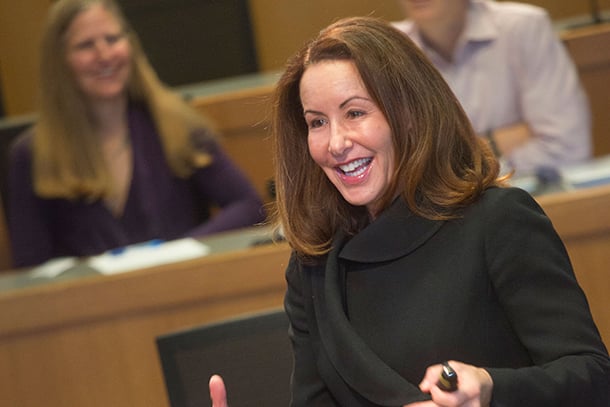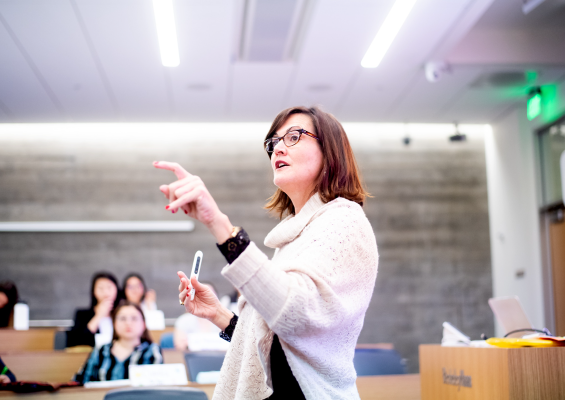Jennifer Chatman, Paul J. Cortese Distinguished Professor of Management, is an energetic, passionate teacher, a Haas alumna (PhD 88), and an expert on organizational culture. As co-founder and director of the Berkeley Haas Culture Initiative, she helps drive research on corporate culture and improve performance and the corporate bottom line.
Her research explores the dangers of narcissistic leaders, how to leverage team diversity, and the benefits of an innovative, adaptive culture. Chatman’s work has been featured in academic journals as well as media outlets ranging from the Wall Street Journal, Inc., and Fortune to Glamour and Working Mother magazine.
A sought-after consultant, she has worked with a broad variety of organizations including Sony, Genentech, Maersk, and Raiders Football.
What excites you most about teaching?
That’s easy—the students! Their level of energy, brilliance, and motivation. I get to stand by this well of excitement and creativity. That never gets old. It’s also humbling in the sense that I need to ensure what I offer them is current and useful.
What differentiates Haas students from those you’ve taught at other business schools?
I’d have to say the Beyond Yourself part of our Defining Leadership Principles. Haas students don’t just want to do something exciting and lucrative for themselves. Many want to change the world in a significant way—either making things better for others or developing an idea that will accelerate other people’s quality of life. Our students are an inspiration.
With Dean Ann Harrison, we’re seeing an evolution of the culture that includes diversity, equity, and inclusion along with entrepreneurship and climate change."
What does it take to build an effective organizational culture?
An effective culture ought to provide employees with a roadmap, particularly with regard to how you make tough trade-offs between competing priorities. In my research, I’ve developed criteria we think is important. The first criterion is that the culture needs to be strategically relevant, meaning people need to prioritize the behaviors that will help the organization get across a designated finish line. Second, the culture needs to be strong, meaning people trust that it’s real. It can’t be hot air that executives spout because it sounds good. It has to be backed by a track record of recognition, hiring practice, and all the things that leaders and others in the organization do to prioritize what’s really important. Finally, the culture has to be adaptive over time. That means it must change a little bit each time you change the strategy.
How does the Haas culture measure up?
We are very proud of the culture we’ve cultivated at Haas. We did it by engaging in all the steps that culture research recommends. Richard Lyons, while serving as dean, codified our Defining Leadership Principles (DLP) in 2010. He drew vast input from others and identified what strategically relevant things differentiated Haas from our competitor schools. We then developed about 180 business processes that have embedded the DLP. You can’t apply to be a student or work at this school without defining how the leadership principles relate to your values. We also reward students and faculty for their orientation toward our DLP.
With Dean Ann Harrison, we’re seeing an evolution of the culture that includes diversity, equity, and inclusion along with entrepreneurship and climate change as themes that now overlay our DLPs.
Why is the Berkeley Haas Culture Initiative so vital for today’s business climate?
The Initiative marries the research world with the organizational world to develop a research agenda that leverages newly available data and methodological approaches. That’s important because for the very first time we have access to the kinds of data that enable us to answer questions that were elusive in the past. Questions like: How quickly does a culture change? Where does change start—from the bottom or the top? How long does it take for merging organizations to integrate their cultures? Today, rather than having to visit each individual organization, we can access digital sources like Glassdoor, where people have volunteered information about their company culture. Such sources contain data on hundreds of thousands of organizations.
The Initiative also rounds out Haas’ portfolio. We’re already known as the business school most differentiated by its culture. So this is the research and corporate arm that reflects our reputation and serves as a knowledge center for how to create an effective organizational culture.
The expertise and insight your professors bring helps deepen and enhance your MBA journey. By selecting a top school with top-notch professors, you maximize your experience.
Read more from the Take 5 with a professor series:
- Bill Pearce says most important trait of a successful marketer is empathy
- Maura O'Neill says narrow-mindedness is the enemy of innovation
- Dave Rochlin talks flipping the classroom: MBAs learn by doing
- Clark Kellogg shares how he teaches design thinking, creativity, and innovation
- Jennifer Cohen talks equitable and inclusive leadership
- Lucas Davis shares hardest economic concept for MBA students to grasp
- Kellie McElhaney talks equity fluency, courage, and vulnerability









